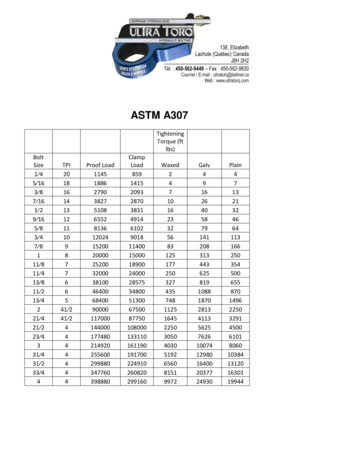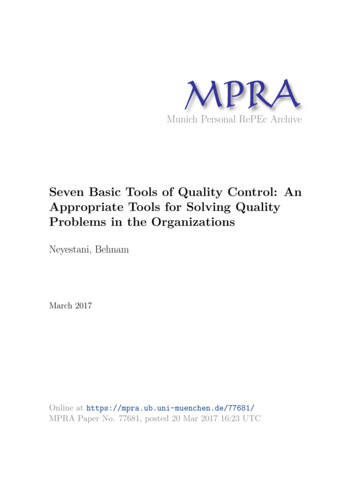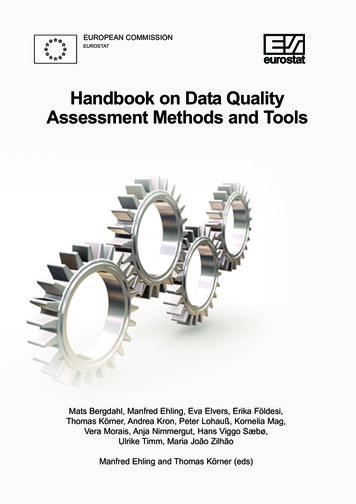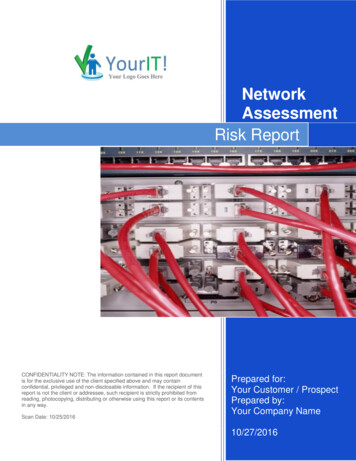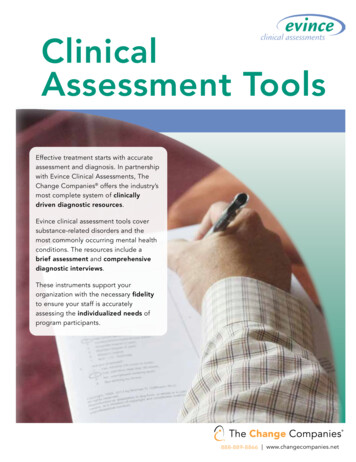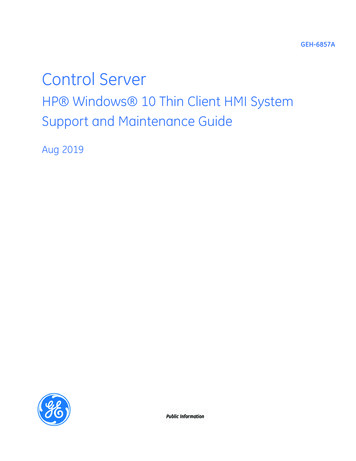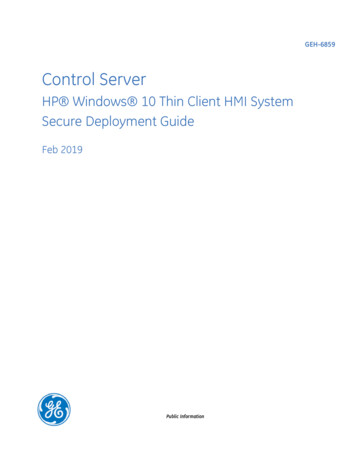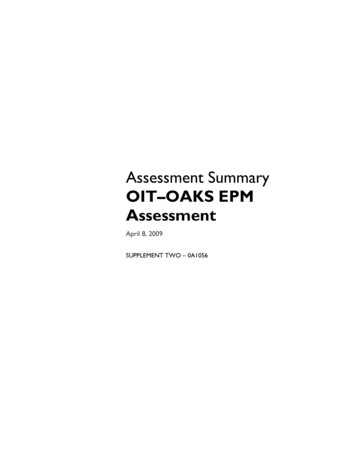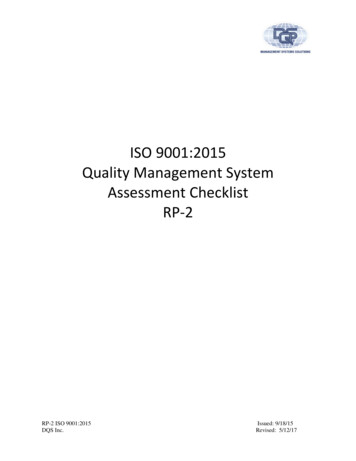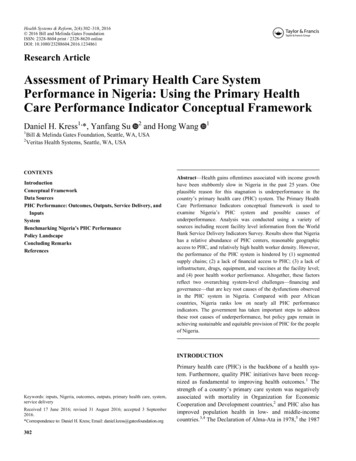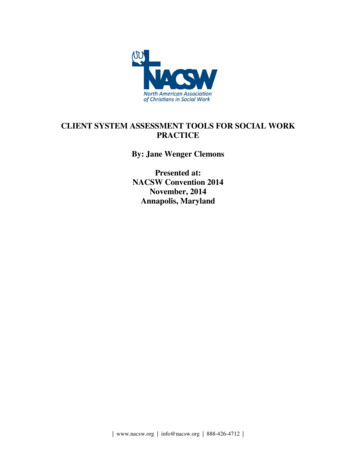
Transcription
CLIENT SYSTEM ASSESSMENT TOOLS FOR SOCIAL WORKPRACTICEBy: Jane Wenger ClemonsPresented at:NACSW Convention 2014November, 2014Annapolis, Maryland www.nacsw.org info@nacsw.org 888-426-4712
Client System Assessment Tools for Social Work PracticeJane Wenger Clemens, MSWNorth American Association of Christians in Social Work2014 NACSW ConventionSetting the Stage: The Important Role of the Social Work ProfessionProfessional social workers are required to develop and practice ongoing social work knowledge,values and skills in order to be competent social workers. This is a career long commitmentembracing both professional growth and personal growth. Our personal well being impacts thewell being of the client systems we serve.Yet, along with this commitment to continue to learn and grow, the social work professionalneeds to be able to handle ambiguity. The reality that many/most situations do not fit a neatpackage; but rather “people making it somehow day to day, hour to hour not without pain,struggle and suffering but with capabilities and resources that can be built upon and supported byour alliance with these possibilities.” (Saleebey, 2013, p. 43)Suppes and Wells call social work “a unique profession” and site three reasons: The dual focus of person and environmentThe strengths perspective in approaching the work, andSocial workers own NASW Code of Ethics (2013, p. 4-5)The author believes these three reasons are what contribute to social work having so much tooffer in primary social work settings and in secondary settings where a social worker’s presenceis a complementation to the professional team. Secondary settings include medical, educational,geriatric, rehabilitation, criminal justice, substance abuse, mental health and a broad array ofother settings.Additionally the attention given to micro, mezzo and macro systems impacting the client systemcreates a lens that broadens understanding of the client situation. There is recognition of theinfluence of privilege, oppression and trauma history. There is value placed on being culturallysensitive as one embraces diversity in the client systems social workers serve.Thus all these components are combined and incorporated as social workers serve client systemseach day in a variety of settings with the rich diversity of clients. This compliments otherdisciplines and offers a unique contribution to professional settings and client systems.1""
Intervention Models: Systematic Interview StepsAs social workers focus on person in environment it is useful to relook at intervention modelsused in practice. For the purpose of this paper, three different intervention models will be named,with one model being highlighted.1. Compton and Galaway feature Phases of the Problem-Solving Model:Phase I - Contact or Engagement PhasePhase II - Contract Phase, including assessmentPhase III - Action Phase, including evaluation(1989, p. 389-391)2. Johnson features the Stages of the Problem-Solving Process:Stage 1 - Preliminary statement of the problemStage 2 - Statement of preliminary assumptions about the nature of the problemStage 3 - Selection and collection of informationStage 4 - Analysis of information availableStage 5 - Development of a planStage 6 - Implementation of the planStage 7 - Evaluation of the plan (1992, p. 55)3. The Intervention Process Model used by Eastern Mennonite University’s social workprogram is the Sheafor, Horejsi, and Horejsi Planned Change Process which has fivephases:Phase I - Intake and EngagementPhase II - Data Collection and AssessmentPhase III - Planning and ContractingPhase IV - Intervention and MonitoringPhase V - Termination and Evaluation (2000, p. 126-127)2""
Sheafor, Horejsi, and Horejsi / Wenger ClemensThis is the five-phase intervention model, which will be referred to for this paper, specificallylooking at Phase II - Data Collection and Assessment.Client System Assessment: Essential Skill for PracticeClient system assessment is one skill social workers use during interventions with clientssystems throughout the intervention process. The models named create a systematic method forproblem-solving or processing client issues. This paper is focusing on the assessmentcomponent.Social workers are aware that micro, mezzo and macro levels impact client systems. In fact onedefinition of Social Systems Theory is the interconnectedness of the person and environment onthe micro, mezzo and macro levels.In generalist social work practice client system assessment is an ongoing social work skill usedwith all intervention levels and throughout the client intervention process. Suppes and Wellsname five “levels of intervention” the individual, family, group, organization and communitylevels (2013).University students and social work practitioners face the challenge of taking an abstractconcept, the “art” of social work as such, and combining it with evidence-based practice skills3""
which need to prioritize and address issues, the “science” of social work as assessment strategiesare utilized.Shulman suggests there are underlying assumptions for the social work practitioner when doingan assessment: people and their environment are interrelated, people face barriers from otherpeople or systems and the social worker must always reach for strengths in people and systems.(1992)Vaughn, Howard and Thyer in their work on evidenced-based social work state: “The pastcentury has witnessed the remarkable growth of practice-relevant scientific research and thereare clear indications that this impressive growth will continue or accelerate for the foreseeablefuture.” (2009, p. 7)Components of Assessment: The challenge of “meeting the client where they are at”How does the social worker effectively “meet the client where they are at” when assessing datacollected from the client system?Shulman reminds practitioners to use empathy in the assessment phase. Social workers need totune in to the client’s sense of urgency and to use one’s senses to fully embrace all the client isfeeling and experiencing. (1992)Chang and Scott express the need for the social worker to be genuine and to explore the meaningof the client’s words and body language. (1999)Sidell and Smiley reinforce the importance of nonverbal behavior in assessment: posture, facialexpression, body position and so on. (2008)Rothman reminds the practitioner to be mindful of the vulnerability of the client. (1999)Dillard and Reilly indicate continual assessment occurs throughout the interview process. Itinvolves not only the client but the worker as well with questions like: Is this approach working?How well did I correct that mistake? Or, Am I making a connection with the client system?(1988).Kadushin suggests, asking the client if there is anything else that might be helpful, is acollaborative effort acting on the worth and dignity of all people, one of social work’s centralvalues. (1983).“Spiritual assessment is defined as an existential relationship with God or a perceivedtranscendence”. (Hodge & Holtrop, 2012, p. 257) and this can be another component ofassessment when the client has raised the issue.Saleebey has created four quadrants when thinking about systematically looking at assessment:4""
(Saleebey, 2013, p. 194)The Council on Social Work Education has created ten core competencies and forty-one practiceskills for acquisition by all social workers who graduate from an accredited social work program.(EPAS 2008).Core Competency 10: Engages, assesses, intervenes, and evaluates generalist social workpractice with individuals, families, groups, organizations, and communities.Assessment10b.1 Collects, organizes, and interprets client data;10b.2 Identifies and assesses client strengths, limitations, and context;10b.3 Develops mutually agreed-upon intervention goals and objectives; and10b.4 Selects appropriate intervention strategies.This mandate is another reason to keep looking at assessment literature and finding tools forassessment strategies.5""
Sensitivity to Diversity and Assessment: Openness to difference and ongoing learningAssessment with diversity also involves extra care around identity formation, intergenerationalissues, cultural conflicts and socioenvironmental impacts.Clients such as refugees and immigrants have major transitions including trauma, language andcultural barriers, documentation issues, acculturation, isolation, added challenges with parenting,employment and education for both adults and children.Social workers need to emphasize strengths even in the midst of challenges. Strengths include:ethnic group solidarity, pride, hard work, endurance, perseverance and the inclusion ofspirituality. (Lum, 2011)The worker who is comfortable with their own race, culture, and ethnicity, is the worker who canbetter try to understand that of another.McAuliffe and Associates lists requirements for being a culturally alert counselor or socialworker: awareness of one’s own cultural values and biases, knowledge of clients’ worldviews,having interventions strategies and culturally alert skills. (2008, p 34-42)Congress’ Culturagram (2013) is recommended by this author for use with immigrants, migrants,refugees and all others facing acculturation issues. Listed are related questions useful inunderstanding someone new to the dominant culture in the U.S.A. It is vital to make noassumptions and be curious and open to respectfully learn and honor differences.Culture is defined as learned beliefs and behaviors that are shared by a group. Culturallysensitive social workers need to have the goal of making no assumptions when working withdiverse client systems.Suggested questions to be used with Congress’ Culturagram:The following are suggested questions to be used by a social worker, as appropriate:1. What brought you to the United States? Tell me about the reason you left your country?(substitute name of country of origin, if known) Have you been abused/hurt? Have youseen others get hurt? Were you ever in a refugee camp?2. How long have you lived in the United States? In this community?3. How old were you when you came to the United States?4. Do you have a green card? There are agencies that can help you go through the process ofgetting a green card (if applicable).5. What language do you speak at home? In the community? How are you managing whenyou interact in the (English) speaking community?6. What clubs or groups or, religious or Faith community do you belong to? (Learn aboutrival groups, or differences within a cultural group, as appropriate)6""
7. When you are sick what do you do? Who helps you? (Be sensitive to a variety of genderissues around privacy and modesty) What do you think contributes to a person not feelingwell?8. What kinds of family parties/celebrations do you have? What are some of the holidaysyou celebrate?9. What events have been stressful for you or your family?10. Do you believe everyone should have a high school education? What do you think aboutcollege education? (Client could have a doctorate and/or a professional training.)11. Help me understand the role of a woman and the role of a man in your family. Who in thefamily earns the money to support the family? Who lives in your house?12. What is important to you? What else do you want to tell me?Assessment Models: Assessment Guides – Social Worker ChecklistsAs mentioned this paper specifically looks at the “Data Collection and Assessment” phase of theintervention process. The author has created two assessment tools, which can be used as achecklist for generalist social work practitioners. These models have a systematic process for thesocial worker to use for assessment purposes, affording clarity regarding priorities and directionwhen working with a client system.The first assessment tool is called “Systems5”. In this tool the social worker is given fivedifferent items that the social worker can use as a checklist in the data collection and assessmentphase. The name “Systems” is used because Social Systems Theory is a foundational orientingtheory for social work practitioners. In “The Social Work Dictionary” Robert Barker definesgeneral systems theory as “A conceptual orientation that attempts to explain holistically thebehavior of people and societies by identifying the interaction components of the system and thecontrols that keep these components (subsystems) stable and in a state of equilibrium. I thereforeconcluded that the heading Systems was an appropriate term to use in a client assessment model.The “5” emerges from the five points to prioritize when working with a client system in the“System5” client assessment tool.7""
Systems5Assessment Guide - Social Worker Checklist1. Situation?What brings the client(s) for services today?Who makes up the client system?2. Safety?Determine if safety is an issue for the client system.Immediately provide resources, support and assistance ifsafety is an issue.3. Survival Needs/Other Needs? Are basic needs being met for the client system?What are other issues to be addressed?4. Supports/Strengths?What supports are in place? What strengths does the clientsystem bring to this process? How were challenges dealtwith previously? What resources are needed?5. Short-term or Crisis Work?Which treatment modality is appropriate with this clientsystem today? How imminent and immediate is the need?Is there time for an ongoing process?Wenger ClemensWhen a social work is truly present with the client, the social worker can listen to what Situationbrought the client at this time, or what is the “presenting issue” as defined by the client? Then, asappropriate, the Safety of the client system needs to be assessed. Survival and other needs aremonitored and the Supports and strengths of the client system are explored and honored. Boththe informal and formal supports and strengths the client system has in place are seen asimportant assets. Lastly a determination is made if the focus demands Short-term work or
“Spiritual assessment is defined as an existential relationship with God or a perceived transcendence”. (Hodge & Holtrop, 2012, p. 257) and this can be another component of assessment when the client has raised the issue. Saleebey has created four quadrants when thinking about systematically looking at assessment: 5" " (Saleebey, 2013, p. 194) The Council on Social Work Education has .
